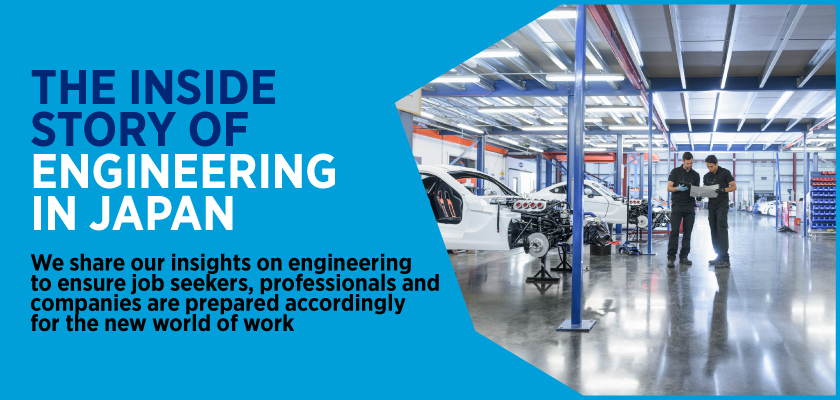Autonomous and electrical vehicles the key for Japan’s resurgent industrial sector
Engineer Inside Story now available to download!

Though Japan’s economy had slowed even prior to the global pandemic, following three straight quarters of decline the second half of 2020 saw an economic rebound, climbing to above pre-corona levels. And as the government’s stimulus initiatives begin to bear fruit, consumer confidence is returning, all of which bodes well for Japan’s industrial sector.
“Japan is the world’s third-largest automotive producing country, and as such it is an essential aspect of the industrial sector,” says Grant Torrens, Managing Director of Hays Japan. “A major reason for this is the country being at the forefront of automotive innovation, with the development of autonomous driving the jewel in the industry crown.”
Japan’s automotive sector has been tireless in its exploration of not only autonomous driving, but also connectivity navigation systems, infotainment and mobility. Domestic companies are investing heavily in a wide range of such technological innovations, and as new trends are uncovered – such as virus filtration systems intended to counter future airborne diseases – this investment is likely to continue, meaning that recruitment drives are unlikely to cease in spite of any future economic slowdowns.
“Whilst autonomous driving captures the headlines, it is perhaps the development of electronic vehicles that is first and foremost on the industry’s mind,” continues Grant. “With governments at both city and national levels announcing plans to halt sales of petrol-powered vehicles, there is a race to establish hybrid and electric vehicles as the transportation of the future. As a consequence, many companies no longer invest in domestic internal combustion engine design, and around 50 per cent of all R&D automotive jobs are for electrical car engineers or related industries.”
Further propelling the transport engineering sphere is the governmental drive for the implementation of mobility-as-a-service (MaaS). This project, that coordinates public transport, car sharing and other services on a trip-by-trip basis, is expected to revolutionise the future of transport in Japan.
“As older technologies become obsolete, the cars of the future will be like a smartphone on wheels,” adds Grant. “The integration of technology by way of the cloud will allow us to locate charging points, drop off our vehicles and find our next connection with barely a thought. Upon realising this potential, it is projected that the domestic MaaS market will reach ¥6.3 trillion by 2030, and as a result, employers are scouring the market for the talent who can actualise the necessary innovations.”
Key to this future of industrial technology is the concept of mechatronics, a branch of engineering that encompasses the virtual facets of software and mechanical hardware.
“For many years software existed solely in the virtual world, but it is now spilling out into the physical world. Whether this is voice controlled domestic products or interacting with the interface of an autonomous car, there is no doubt that mechatronics will be evermore present in our daily life. Therefore, anyone who wishes to reach new heights in their career – whether that be a university student or a seasoned professional looking to transition into a new area – should be considering mechatronics.
“And as many international companies require contact points with R&D hubs abroad, another skillset that employers demand is English ability,” says Grant. “This is a perennially job-rich and candidate-poor area in a country where less than two per cent of the population is fluent in the language, though as bilingual engineering candidates can expect 20 to 30 per cent higher salaries than their unilingual counterparts, it is certainly an upskilling area worth exploring for ambitious professionals.”
An overview of what other trends have been observed in Japan’s engineering sector can be viewed below:
- Junior to mid-level roles currently most in demand are application engineer, project manager and sales engineer. Those with skillsets that include an engineering background that enables them to conduct technical discussions with clients, presentations skills and product design experience are most sought after.
- Candidate-short senior roles include sales engineering managers and engineering directors. Necessary skillsets include excellence in team management, negotiation, presentation, experience interacting with customers and bilingualism.
- Whilst the most common way for candidates to research prospective positions remains jobs boards such as Recruit Navi and Career Cross, there is a growing trend for the use of other social networks such as LinkedIn and the Hayes website.
- The production of drones used as surveillance for imaging hazardous areas is expected to grow. This, plus the development of VTOL, will attract start-ups and large companies alike over the next three to five years.
To download the Inside Story of Engineering in Japan report, please click here.
Reports
Whitepapers
The Future of Work: How AI is impacting your workforce
2024/2025 Hays Asia DE&I report
The Workforce of the Future Report
2024 Japan’s Technology Talent Trends
2024 Japan Accountancy and Finance Talent Trends
Future of Asia’s Technology Industry
Diversity, Equity & Inclusion Report
DNA series
